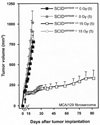Impact of stromal sensitivity on radiation response of tumors implanted in SCID hosts revisited
- PMID: 20924105
- PMCID: PMC2976483
- DOI: 10.1158/0008-5472.CAN-10-1871
Impact of stromal sensitivity on radiation response of tumors implanted in SCID hosts revisited
Abstract
Severe combined immunodeficient (SCID) mice carry a germ-line mutation in DNA-PK, associated with deficiency in recognition and repair DNA double-strand breaks. Thus, SCID cells and tissues display increased sensitivity to radiation-induced postmitotic (clonogenic) cell death. Nonetheless, the single-radiation doses required for 50% permanent local control (TCD(50)) of tumors implanted in SCID mice are not significantly different from the TCD(50) values of the same tumors in wild-type hosts. Whereas the tumor stroma is derived from the host, the observation that tumors implanted in SCID mice do not exhibit hypersensitivity to radiation might imply that stromal endothelial elements do not contribute substantially to tumor cure by ionizing radiation. Here, we challenge this notion, testing the hypothesis that ASMase-mediated endothelial apoptosis, which results from plasma membrane alterations, not DNA damage, is a crucial element in the cure of tumors in SCID mice by single-dose radiotherapy (SDRT). We show that the endothelium in MCA/129 fibrosarcomas and B16 melanomas exhibits a wild-type apoptotic phenotype in SCID hosts, abrogated in tumors in SCID(asmase-/-) littermates, which also acquire resistance to SDRT. Conversion into a radioresistant tumor phenotype when implanted in SCID(asmase-/-) hosts provides compelling evidence that cell membrane ASMase-mediated microvascular dysfunction, rather than DNA damage-mediated endothelial clonogenic lethality, plays a mandatory role in the complex pathophysiologic mechanism of tumor cure by SDRT, and provides an explanation for the wild-type SDRT responses reported in tumors implanted in SCID mice.
©2010 AACR.
Conflict of interest statement
The authors have declared that no conflicts of interest exist.
Figures






References
-
- Brown M, Bristow R, Glazer P, et al. Comment on "Tumor response to radiotherapy regulated by endothelial cell apoptosis" (II) Science. 2003;302:1894. author reply. - PubMed
-
- Budach W, Taghian A, Freeman J, Gioioso D, Suit HD. Impact of stromal sensitivity on radiation response of tumors. J Natl Cancer Inst. 1993;85:988–993. - PubMed
-
- Fuks Z, Kolesnick R. Engaging the vascular component of the tumor response. Cancer Cell. 2005;8:89–91. - PubMed
-
- Garcia-Barros M, Paris F, Cordon-Cardo C, et al. Tumor response to radiotherapy regulated by endothelial cell apoptosis. Science. 2003;300:1155–1159. - PubMed
-
- Gerweck LE, Vijayappa S, Kurimasa A, Ogawa K, Chen DJ. Tumor cell radiosensitivity is a major determinant of tumor response to radiation. Cancer Res. 2006;66:8352–8355. - PubMed
Publication types
MeSH terms
Grants and funding
LinkOut - more resources
Full Text Sources
Molecular Biology Databases

